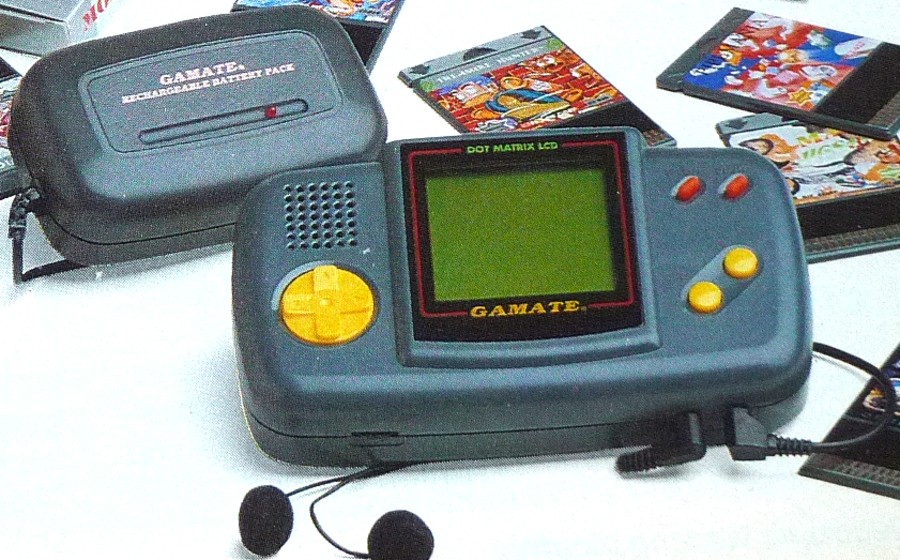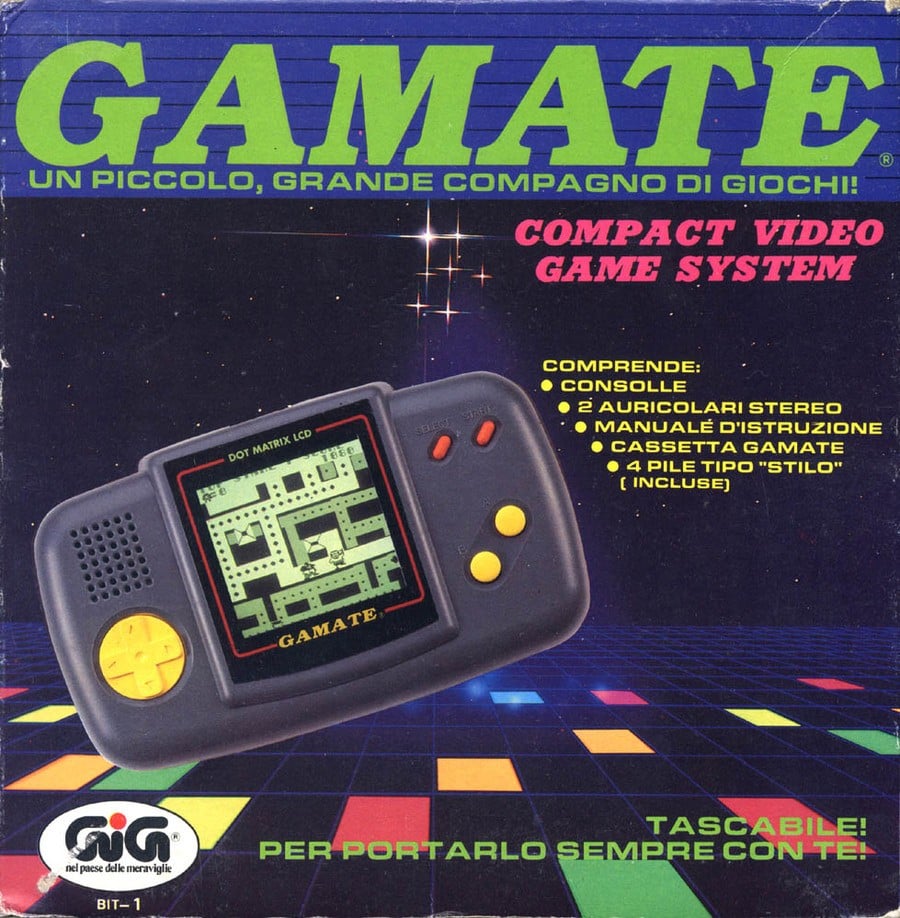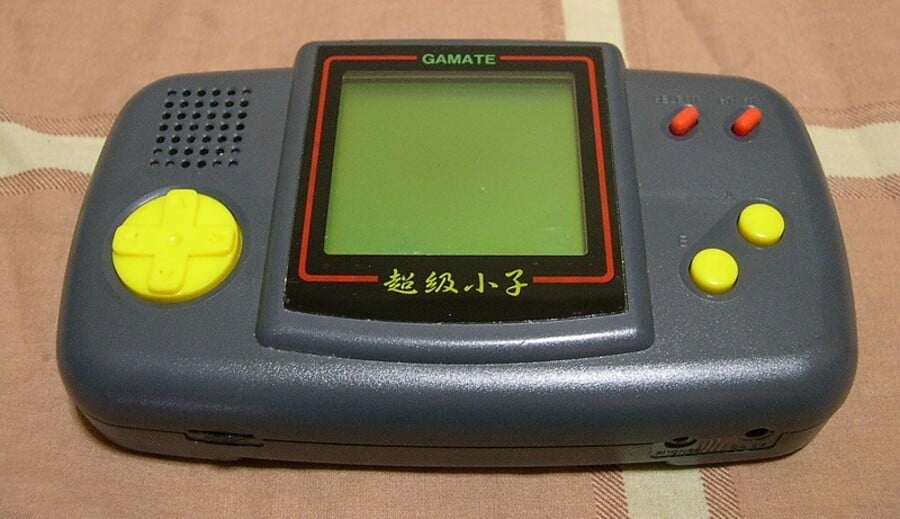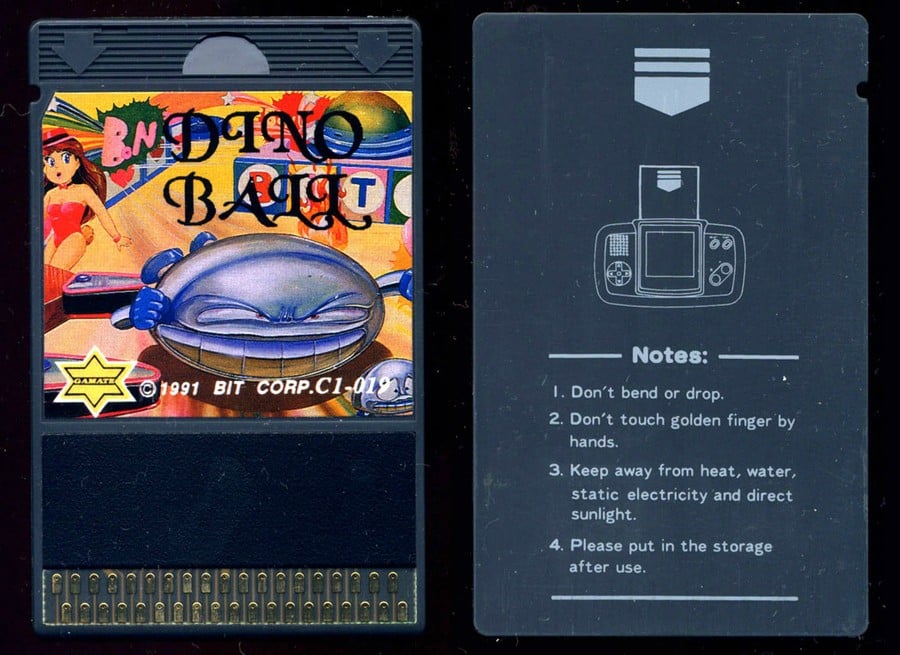
When Nintendo launched the original Game Boy to a rapturous critical and commercial reception in 1989 it was almost a forgone conclusion that other companies would follow suit and concoct their own portable systems. Arch-rival Sega quickly pushed the Game Gear onto store shelves and industry veteran Atari contributed the tremendously powerful Lynx, but less famous pretenders to the throne also appeared, including the little-known Gamate, manufactured by a tiny Asian firm known as Bit Corp.
"Bit Corp was one of Taiwan's first video game companies, active since at least the early 80s," recounts Alex Evans, webmaster of gaming curio website NeoFuji and arguably the world’s leading source of Gamate knowledge. "It developed a number of games for the Atari 2600, many of which saw release in Europe. With the rise of the Famicom in the mid-'80s Bit Corp moved onto that system with Duck Maze — the first Taiwanese-developed Famicom game — in 1987 and published at least four more titles in the following two years."
Software was just one facet of the company's business, though. "Bit Corp also produced hardware — mostly clones of other popular consoles," continues Evans. "But they tended to be a cut above the generic copies their contemporaries were producing. Aside from the obligatory Atari 2600 and Famicom clones, it released two computers — the Bit-60 and Bit-90 — which were based on Atari 2600 and ColecoVision hardware respectively and maintained compatibility with each console's cartridges. Bit Corp also exploited the similarity between the ColecoVision and Sega's SG-1000 to create a hybrid console called the Dina 2-in-1, which was sold as the Telegames Personal Arcade in the US."

Taking this past history into account, it's clear that Bit Corp had a lot of experience with video game hardware and was therefore perfectly positioned to capitalise on the new-found public appreciation for portable gaming. Unsurprisingly, given the company’s penchant for plagiarising the work of other firms, the resultant Gamate device shared many similarities with Nintendo's groundbreaking handheld. "While it’s difficult to determine exactly what kind of CPU the Gamate has — it appears to be a custom part, and the manual only states that it's 8-bit — the console has the same type of display, same amount of RAM, same control configuration and very similar graphical and audio capabilities to the Game Boy," explains Evans. "It even takes the same kind of AC adapter. Clearly it was heavily inspired by Nintendo's machine, but I don't think it's an exact clone, as some have speculated — the screen resolution seems to be slightly different, for example."
"The LCD display on the Gamate has the same problem as the original Game Boy, only about ten times worse; it suffers from shocking motion blur"
One area where the Gamate differed from the Game Boy was the way in which its games were delivered, with Bit Corp favouring a card-style format similar to examples previously seen on the NEC PC Engine and Sega Master System. “Much like NEC and Sega's cards, they're roughly credit-card sized, only somewhat thicker and the majority of the card is actually solid plastic that only serves as a place for the label to go," says Evans. "The PCB is only about a third of the entire card's length, and consists of two small chips on a thin board, covered in epoxy and glued down. I'm not sure why this format was chosen — a more traditional Game Boy-style cartridge would have offered more space for larger ROM chips and extra features like a save battery, allowing the developers to create larger, more complex games — but it certainly stands out in people's minds as a pretty unique feature and it's always nice to be able to store your games in your wallet."
While Bit Corp clearly wished to emulate the performance of its more illustrious rival, the humble origins of the company resulted in a few corners being cut — the most obvious being the poor-quality screen. This shortcoming would have a dramatic effect on the public perception of the device. "The LCD display on the Gamate has the same problem as the original Game Boy, only about ten times worse; it suffers from shocking motion blur," laments Evans. "This actually renders some games — such as the vertical shooter Tornado — nearly unplayable, because small, fast-moving objects like bullets become invisible. Some later models of the console feature a slightly improved screen, which goes some way towards alleviating this issue; it isn't perfect but at least you can see everything. Bit Corp appear to have been using both the good and bad screens at the same time, so it may well have been a case of them using two different screen suppliers simultaneously for one reason or another, rather than making a conscious effort to fix the problem."
Given Bit Corp’s diminutive stature and lack of budget, there was never any question of the company marketing the Gamate in territories outside of its homeland. However, thanks to the success of the Game Boy and the sudden interest in portable gaming, Bit Corp was able to secure distribution deals which got the device into an impressive number of different countries — albeit with a relatively low-key results. "The Gamate appears to have been released in most major video game markets, possibly excluding Japan," reveals Evans. "I know for sure it was sold in the UK, Italy, France, Germany, Switzerland, North America, Argentina, Uruguay, Taiwan and possibly mainland China, although units probably made their way into many more countries via local distributors."
Joystick manufacturer Cheetah took on the UK distribution duties, clearly hoping that Game Boy fever would rub off on this plucky new challenger. It certainly had a fighting chance; the unit itself launched at a very reasonable £59.95 (approximately $99 / 73 Euros) — £10 less than Nintendo was selling its machine for – and software retailed for around £15 ($25 / 18 Euros). Sadly the critical reaction wasn't favourable, with reviews highlighting the lack of big-name titles, poor screen and generally dire quality of software as being the main reasons to leave the console on the shelf. The Gamate never got off the ground in the United Kingdom and Cheetah eventually abandoned the format – although that didn't quite mark the end of the console’s British aspirations. "Interestingly, it seems to have been released in the UK twice," says Evans. "First by Cheetah, then again by Maplin, though it looks like they had similar trouble shifting them. I've seen game boxes with 99p ($1.65 / 1.20 Euros) stickers on them...games that now go for £50 ($80 / 60 Euros) or more on eBay."
Elsewhere in Europe, the Gamate found more a somewhat warmer reception. "The Italian distributor of the machine – GiG — was actually quite a major player in the toy business," explains Evans. "They were the official distributor for the NES in the country, so presumably were able to use their marketing clout and sales network to get the console into far more homes than it managed elsewhere." Indeed, most of the Gamate titles currently changing hands on eBay are Italian variants, which suggests the format experienced a modicum of success in that particular region.

One of the reasons that the Game Boy was so triumphant was because it enjoyed a surfeit of support from renowned third-party developers like Capcom, Konami, Taito and Electronic Arts. The Gamate on the other hand had to rely largely on internal development to create its modest library of titles, with Bit Corp’s overworked and underappreciated programmers handling most of this output. "There were no third-party publishers, but I know of at least two external developers working under contract with Bit Corp: Gamtec Corp, based in Taiwan, and Hengmao Electronics, in mainland China," reveals Evans. "Together, these companies managed to produce at least 71 games during the console's lifetime, which — in terms of quantity, at least — puts the Gamate ahead of every other minor player in the handheld market, including such far more well-known flops as the Nokia N-Gage, Tiger Game.com, Watara Supervision and Gizmondo."
"The developers weren't incompetent by any means, but they were clearly under pressure to get as much product out of the door as possible with limited time and resources to do so"
However, quantity doesn't always result in quality, as Evans freely admits. "The games themselves are a mixed bag, once you get past the console's audiovisual issues; they're not as uniformly terrible as some people make them out to be, but nor are they good enough to make the Gamate anything more than an interesting curiosity. Many show promise but were clearly rushed, which is a shame. Myth of Asamia is a good example of this – it’s an otherwise decent platformer ruined by shoddy jumping controls. Another game, Flying Goblin, was even released with the description to an entirely different game — Mars Voyage — on the back of the box. The developers weren't incompetent by any means, but they were clearly under pressure to get as much product out of the door as possible with limited time and resources to do so — after all, Bit Corp was a small company, with development support from a couple of even smaller companies, trying to take on a multinational behemoth with the world's biggest developers and publishers behind it."
As was common practice in the age of the 8-bit micro computer, the Gamate’s software library was packed full of shameless copies of existing hits, all of which Bit Corp had neither the inclination nor the funds to acquire and develop legitimately. Games cunningly replicated for the handheld include Super Pang (Boom), Pitfall (Monster Pitfall), Bomberman (Bomb Blaster), Lode Runner (Witty Apee and Treasure Hunter), Galaxian (Galaxy Invaders), Battle City (Mighty Tank), Breakout (Brick Blaster), Lock 'n' Chase (Money Maze) and Tetris (Cube-Up). Pipemania was also ported to the console under its original name, although it doesn't appear to be a licensed version. Finally we have the aforementioned Mars Voyage, which isn't a clone as such but bears more than a passing resemblance to Konami’s Gradius, right down to a Moai statue featuring on the back of the box. Given Bit Corp’s lack of cash and humble talent as a creator of games, it’s almost forgivable that so many of the Gamate’s titles were wholesale rip-offs, but sadly few – if any – of these copies managed to come anywhere near to the quality of the software they intended to emulate.
Despite its relatively short lifespan, the Gamate hardware underwent some subtle revisions — many of which are only obvious to those collectors who are savvy enough to spot the slight differences. "The main chipset appears to have been revised at some point during the production run, although this was presumably done for cost reasons as it doesn't seem to have any discernible effect on performance," states Evans. "I've also been in touch with a Taiwanese collector who owned a white machine which they described as 'second-generation' but everything other than the colour appears to be identical. Internally, there are at least a couple more variations to be found — perhaps the most noticeable is the screen, which I touched upon earlier. The easiest way to tell which one you have is by turning the Gamate on without a game in - the 'bad' one displays horizontal lines while the 'good' one displays a slightly corrupted checkerboard pattern."
Some iterations of the machine are incredibly rare and highly sought-after by fans. "The very earliest versions of the Gamate featured a noticeably different case design, with different speaker holes, button recesses and D-pad, but this is considerably rarer than the standard version," explains Evans. "I've seen one for sale on eBay, but none of the Gamate owners I've been in touch with actually have one."
By 1992, the strain of keeping the Gamate dream alive proved to be too much for Bit Corp; the company hit shaky financial ground but astonishingly the demise of its manufacturer didn't spell the end for the underdog console. "Gamate production was taken over by the semiconductor manufacturer UMC and its subsidiary Funtech, which was also known as Dunhuang Technology," states Evans. This move was actually a smoother transition than you might otherwise expect, as UMC played a major part in the birth of the machine, albeit as a chip supplier rather than a creative force. "All Gamate consoles contain a UMC chip, but UMC chips were a fairly ubiquitous presence in all Taiwanese game consoles of the period — most early Famicom clones used UMC's copies of Nintendo chips, for example," explains Evans. "It may have been the case that UMC initially just supplied chips to Bit Corp, before taking over the whole Gamate operation as its first foray into the video game market after Bit Corp's demise."

Despite battling on under the arm of UMC and managing to carve out a modest niche in Italy, the Gamate eventually fell by the wayside in the face of the Game Boy's unrelenting dominance and the gaming public's crushing indifference. A colour version of the console was mooted at one point, but Evans is unconvinced it was anything more than an idle rumour intended to keep already slim hopes alive. "I've been unable to find any evidence of its existence," he admits. "Supposedly, it was exhibited at CES and mentioned in a US game magazine, but I could never find the magazine in question or anything else more substantive than rumours about it being released in small quantities in Taiwan. or entirely unlikely places like Mexico."
"Judging by the scarcity of second-hand units, it seems to have been a pretty spectacular flop — it was certainly in no danger of bothering the Game Boy, Game Gear, or even the Lynx"
By the close of 1993 the Gamate was all but deceased, with only the most dedicated of fans mourning its demise. The lack of solid figures makes it hard to determine just how poorly it sold, but it’s pretty obvious that it wasn't a commercial smash-hit by any stretch of the imagination. "Judging by the scarcity of second-hand units, it seems to have been a pretty spectacular flop — it was certainly in no danger of bothering the Game Boy, Game Gear, or even the Lynx," states Evans.
Clearly in the pantheon of video gaming the Gamate occupies a pretty lowly perch and even hardcore fan Evans struggles to counter such a viewpoint; in purely business terms the console can only be seen as a devastating disappointment. "Even in Italy, where it seems to have done comparatively well, it evidently didn't do quite well enough for its distributor to release the later games," he admits. "The only way to know for sure if it was truly a commercial failure is to find out whether Bit Corp and UMC actually made money on the project. It was never going to outsell the Game Boy but it may well have been a success by their own modest standards. The fact that Bit Corp went bust during the system's lifetime is hardly an encouraging sign, but UMC must have done decent enough business to not be put off the games industry completely – although it’s worth noting that the firm’s second console, the 16-bit Super A'can, would lose the UMC $6 million and lead to the closure of its entire game division."
Ironically, the Gamate's humble standing in the world of portable entertainment has made it highly sought-after system in retro collecting circles, with unboxed machines fetching as much as £50 ($80 / 60 Euros) on the rare occasions they actually turn up on eBay. "I'd say it's down to its extreme obscurity coupled with a fairly large software library," comments Evans when asked about this bizarre and almost frenzied demand for failed hardware. "It’s quite unusual for a console that most people — even most retro enthusiasts — have never heard of to have had over 70 games released for it. I suspect the fact that it has never been emulated is also a factor; the only way to play any of those games is to actually own them."
It would seem that the Gamate is destined to be considered a weird and wonderful collectable rather than a truly worthy gaming platform. Its abject failure and relatively unknown status appear to be the driving factors in its appeal to truly hardcore retro enthusiasts; certainly as a console it offered little in the way of mouthwatering features. "I have to admit it's pretty unacceptable that the vast majority of Gamate consoles are equipped with a screen that actually renders several of its games unplayable," Evans says. "The speaker is equally poor, too; some Gamate games have fairly good music, but you'd never notice without headphones. Having said that, there's nothing particularly wrong with the actual design of the machine; it was just let down by crap parts being used in the most obvious places. In a way, it's impressive they got as far as they did, but ultimately they took one too many shortcuts and sacrificed too much quality for quantity when it came to software. Perhaps if they had cut the number of games by half and delayed the console's release to work out its hardware problems and give the developers more time to polish things up, they could have had a minor success on their hands. Unfortunately it wasn't to be.”
This feature originally appeared in its entirety in Imagine Publishing’s Retro Gamer magazine, and is reproduced here with kind permission.





Comments 38
Nice read. I love retro stuff and obscure stuff, and this is both of those things.
From the name, I could say that they REALLY wanted to take on the Game Boy.
As an Aussie I cant read that name without hearing it as "gay mate"
Despite its origins they manage to stay in business for a long while wow.
There was also the Mega Duck, a handheld console by Hong Kong-based company Welback Holdings. It also tried to rival the Game Boy but failed. Welback also made unlicensed NES games (Little Red Hood, anyone?).
Nintendo handhelds always dominate sales. Kudos to the Vita for picking up their sales recently.
@Ichiban I think most people read it that way. Not that there's anything wrong with that.
I love these features in NintendoLife.com.
Very fascinating. I love reading articles of gaming's past, and this is no exception.
@Ichiban
That's how I read it too. I couldn't help laughing when I read it and imagined the instruction manuals saying something like "insert it in the slot at the rear of your gamate" when explaining the game cards.
I remember seeing the before. The yellow dpad and buttons bring back some memory of it. Most likely just saw one on a store shelf at some point.
Also from what I could find the later models had better screens
I had no idea this existed.
brb gotta throw my 3DS in the garbage and find one of these babies on eBay.
So, uh, how is that name pronounced? ˈgā-ˈmāt..?
@Mahe Gamate as in "homosexual friend" http://www.youtube.com/watch?v=aIsKG-pewM0
I never knew this existed until just now. Very cool!
Oh yeah! I remember reading a wiki entry about this thing.
I don't think I'll ever plan to get one though
Nintendo needs to make Gamate Virtual Console games happen pronto!
@ReshiramZekrom
I know right? I had that device at home back in the day. The music in the games was not that bad, but overall the games were rather basic if I remember correctly.
@ManInTheChair … I remember that… I wonder whatever happened to the one I used to own?
Oh! Oh! Anyone remember an almost Virtual Boy-Eque machine that was a headband with a single eye piece? I think it later had a version that did away with the DBZ Scouter design for a more Practical portable design… I can't remember much else, other than plenty of red and black in design of the "machine", "carts", and games, and I think the carts were their own screens? Like Game and Watch/other One Game Portables style LCD screens…?
As to This machine… it does look very cheaply produced. That D-Pad especially looks… questionable. The outer casing also looks cheap enough to make me wonder if the lack of a second hand market is because of little sales success, or because of a poor survival rate. It reminds me of some of the more modern portable… I'm not even sure if they can be called Knock Offs, because I don't know if they're knocking anything off with anything other than their names…
Anyway, it reminds me of those a little, though the screen is at least not that same kind of as Game And Watch…
@ChessboardMan I think that was Tiger's R-Zone
And they said the Wii has a silly name! I had never heard of this console before but there's no way I'm going to forget it
@Damo This was a really interesting story to read, thanks! I should buy Retro Gamer more often.
I want one
So its like a vita without the Sony name going against the 3ds?
As in sales that is(even though vita is picking up some slack)
Interesting... Never heard of this system before, but no real surprise I suppose. I was after all living in a country that wasn't even selling Gamate handhelds. No surprise it failed either, what with the screen being shoddy for displaying games most of the time. Still, would have been interesting to see it be modestly successful with the right development and care put into it. Maybe then the company would still be in the console business to this day...
Lovely article though, Damien.
@Smashbro99 that's the one…
You're one ugly mother!!!
Boy did that thing look like it was made out of cheap materials.
No wonder nobody was fooled.
I...think I had one of these. It looks awfully familiar to a present I got from my grandma, who bought it off the Home Shopping Network way back when. If it's the same machine, I remember it being a pile of hot trash. Definitely no R-Zone.
@JonWahlgren Do you still have it?
@AnActualDash @Ducutzu @WingedSnagret @Squashy @Lunapplebloom Thanks for the kind words! Really pleased you all liked the piece, it was fun to write. I actually saw an advert for one of these in a copy of Computer & Video Games magazine WAAAAY back in the early '90s and wanted one so badly. Funny how things stick with you!
@Damo As a video game hoarder I don't think I would've ever thrown it away intentionally, but since we moved a lot I have no idea where it may have ended up. If I do then it's locked in a storage facility on the other side of the country.
I know for truthfacts that I still have my R-Zone in said storage facility. Next time I'm back east I'll dig it up. Pretty sure it's in the same box as my Game.com.
I never knew this thing existed at all but this left me with two thoughts. First, I reaalllly miss my Game.com..first handheld I owned that let you pop in two carts. Second the idea of having games in your wallet is too good! Nintendo really should start making more AR games as well as creating some NFC games that come on cards.
Ultra-rare white version on Ebay right now. Comes with original packaging and game, get it while it's hot.
http://www.ebay.com/itm/Bitcorp-Gamate-ULTRA-RARE-WHITE-EDITION-handheld-game-console-like-gameboy-/271331389931?pt=Video_Games&hash=item3f2c9c71eb
@JonWahlgren Seriously, I will furnish you with dollar dollar bills y'all if you do have a Gamate. I'm not even joking!
@Ichiban Yuh, my sentiments exactly. lol
I'm surprised no one has released a key chain version of this epic console with all of the games in one.
Show Comments
Leave A Comment
Hold on there, you need to login to post a comment...